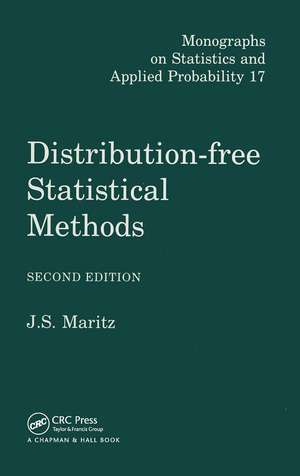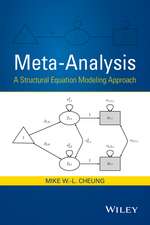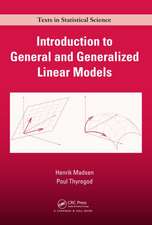Distribution-Free Statistical Methods, Second Edition: Chapman & Hall/CRC Monographs on Statistics and Applied Probability
Autor J.S. Maritzen Limba Engleză Hardback – apr 1995
This new edition is aimed at senior undergraduate and graduate level. It also includes a discussion of new techniques that have arisen as a result of improvements in statistical computing. Interest in estimation techniques has particularly grown, and this section of the book has been expanded accordingly. Finally, Distribution-Free Statistical Methods includes more examples with actual data sets appearing in the text.
Din seria Chapman & Hall/CRC Monographs on Statistics and Applied Probability
- 9%
 Preț: 731.83 lei
Preț: 731.83 lei -
 Preț: 347.49 lei
Preț: 347.49 lei -
 Preț: 328.46 lei
Preț: 328.46 lei - 9%
 Preț: 1243.61 lei
Preț: 1243.61 lei - 9%
 Preț: 645.60 lei
Preț: 645.60 lei - 8%
 Preț: 396.90 lei
Preț: 396.90 lei -
 Preț: 373.59 lei
Preț: 373.59 lei - 8%
 Preț: 397.48 lei
Preț: 397.48 lei - 9%
 Preț: 1040.72 lei
Preț: 1040.72 lei - 9%
 Preț: 643.14 lei
Preț: 643.14 lei -
 Preț: 340.83 lei
Preț: 340.83 lei - 9%
 Preț: 645.45 lei
Preț: 645.45 lei - 9%
 Preț: 682.97 lei
Preț: 682.97 lei - 20%
 Preț: 690.21 lei
Preț: 690.21 lei - 18%
 Preț: 1111.90 lei
Preț: 1111.90 lei - 18%
 Preț: 1115.51 lei
Preț: 1115.51 lei - 9%
 Preț: 606.13 lei
Preț: 606.13 lei - 18%
 Preț: 1118.65 lei
Preț: 1118.65 lei - 18%
 Preț: 1118.99 lei
Preț: 1118.99 lei - 25%
 Preț: 526.38 lei
Preț: 526.38 lei - 25%
 Preț: 427.84 lei
Preț: 427.84 lei -
 Preț: 486.70 lei
Preț: 486.70 lei - 25%
 Preț: 499.81 lei
Preț: 499.81 lei - 15%
 Preț: 674.37 lei
Preț: 674.37 lei - 25%
 Preț: 487.34 lei
Preț: 487.34 lei - 26%
 Preț: 876.78 lei
Preț: 876.78 lei - 18%
 Preț: 703.79 lei
Preț: 703.79 lei - 27%
 Preț: 996.14 lei
Preț: 996.14 lei - 22%
 Preț: 413.08 lei
Preț: 413.08 lei - 25%
 Preț: 456.19 lei
Preț: 456.19 lei - 15%
 Preț: 489.26 lei
Preț: 489.26 lei - 18%
 Preț: 760.35 lei
Preț: 760.35 lei - 15%
 Preț: 718.62 lei
Preț: 718.62 lei - 26%
 Preț: 877.30 lei
Preț: 877.30 lei - 18%
 Preț: 919.10 lei
Preț: 919.10 lei - 28%
 Preț: 631.16 lei
Preț: 631.16 lei - 27%
 Preț: 1000.51 lei
Preț: 1000.51 lei - 29%
 Preț: 627.88 lei
Preț: 627.88 lei - 18%
 Preț: 1280.44 lei
Preț: 1280.44 lei - 23%
 Preț: 376.17 lei
Preț: 376.17 lei - 18%
 Preț: 1156.73 lei
Preț: 1156.73 lei - 18%
 Preț: 1326.99 lei
Preț: 1326.99 lei - 15%
 Preț: 671.64 lei
Preț: 671.64 lei - 15%
 Preț: 676.33 lei
Preț: 676.33 lei - 15%
 Preț: 489.26 lei
Preț: 489.26 lei
Preț: 1106.98 lei
Preț vechi: 1349.99 lei
-18% Nou
Puncte Express: 1660
Preț estimativ în valută:
211.81€ • 221.75$ • 175.27£
211.81€ • 221.75$ • 175.27£
Carte tipărită la comandă
Livrare economică 07-21 aprilie
Preluare comenzi: 021 569.72.76
Specificații
ISBN-13: 9780412552601
ISBN-10: 0412552604
Pagini: 268
Dimensiuni: 138 x 216 x 17 mm
Greutate: 0.39 kg
Ediția:2Revizuită
Editura: CRC Press
Colecția Chapman and Hall/CRC
Seria Chapman & Hall/CRC Monographs on Statistics and Applied Probability
ISBN-10: 0412552604
Pagini: 268
Dimensiuni: 138 x 216 x 17 mm
Greutate: 0.39 kg
Ediția:2Revizuită
Editura: CRC Press
Colecția Chapman and Hall/CRC
Seria Chapman & Hall/CRC Monographs on Statistics and Applied Probability
Public țintă
ProfessionalCuprins
1 Basic concepts in distribution-free methods -- 1.1 Introduction -- 1.2 Randomization and exact tests -- 1.3 Test statistics and estimating equations -- 1.4 Consistency in the one parameter case -- 1.5 Confidence limits -- 1.6 Efficiency considerations in the one parameter case -- 1.6.1 Estimation -- 1.6.2 Hypothesis testing -- 1.7 Estimation of standard errors -- 1.8 Multiple samples and parameters -- 1.8.1 Introduction -- 1.8.2 Point estimation -- 1.8.3 Hypothesis testing -- 1.8.4 Confidence regions -- 1.9 Normal approximations -- 1.9.1 The need for normal and related approximations -- 1.9.2 The central limit theorem -- 1.9.3 Sampling from finite populations -- 1.9.4 Linear rank statistics -- 2 One-sample location problems -- 2.1 Introduction -- 2.1.1 The mean -- 2.1.2 The median -- 2.1.3 Other measures of location -- 2.2 The median -- 2.2.1 The sign statistic -- 2.2.2 The null distribution of the sign statistic -- 2.2.3 Hypothesis testing -- 2.2.4 Confidence limits for ø -- 2.2.5 Point estimation of ø -- 2.2.6 Estimating the standard error of the sample median -- 2.2.7 Efficiency considerations -- 2.2.8 Computational notes -- 2.3 Symmetric distributions -- 2.4 The mean statistic -- 2.4.1 Hypothesis testing -- 2.4.2 Confidence limits -- 2.4.3 Normal approximations -- 2.4.4 Point estimation and efficiency considerations -- 2.4.5 Computational note -- 2.5 The Wilcoxon signed rank statistic -- 2.5.1 The null distribution of W -- 2.5.2 Hypothesis testing -- 2.5.3 Confidence limits -- 2.5.4 Point estimation based on W -- 2.5.5 Efficiency -- 2.5.6 Estimating the variance of the Hodges-Lehmann estimate -- 2.5.7 Computational notes -- 2.6 Other rank based transformations -- 2.6.1 Scores based directly on ranks -- 2.6.2 The null distribution of w, -- 2.6.3 Hypothesis testing -- 2.6.4 Confidence limits -- 2.6.5 Point estimation -- 2.6.6 Efficiency -- 2.6.7 Optimum rank statistics -- 2.7 Robust transformations -- 2.8 M-estimates -- 2.8.1 Hypothesis testing and confidence limits -- 2.8.2 Point estimation and efficiency -- 2.9 M-estimation and scaling -- 2.9.1 Hypothesis testing -- 2.9.2 Point estimation and confidence limits -- 2.9.3 Estimating the variance of an M -estimate -- 2.10 L-estimates -- 2.11 Ties -- 2.12 Asymmetric distributions: M-estimates -- 3 Miscellaneous one-sample problems -- 3.1 Introduction -- 3.2 Dispersion: the interquartile range -- 3.2.1 Symmetric F, known location -- 3.2.2 General F -- 3.3 The sample distribution function -- 3.3.1 One-sided confidence bands for F -- 3.4 Estimation of densities -- 3.4.1 Estimation of F when some observations are censored -- 3.4.2 The actuarial method of estimating F -- 3.4.3 The product-limit estimate ofF -- 3.5 Paired comparisons -- 3.5.1 Signed rank tests -- 3.5.2 Sign tests -- 4 Two-sample problems -- 4.1 Types of two-sample problems -- 4.2 The basic randomization argument -- 4.3 Inference about location difference -- 4.3.1 Introduction -- 4.3.2 The two-sample mean statistic -- 4.3.3 The two-sample sign statistic -- 4.3.4 The two-sample rank sum statistic -- 4.3.5 1\vo-sample transformed rank statistics -- 4.3.6 Robust transformations in the two-sample case -- 4.4 Multiplicative models -- 4.5 Proportional hazards (Lehmann alternative) -- 4.5.1 The Wilcoxon statistic and inference about a -- 4.5.2 The 'log-rank' test and inference about a -- 4.5.3 Conditional likelihood and the log-rank test -- 4.5.4 The log-rank test and censored observations -- 4.6 Dispersion alternatives -- 4.6.1 A randomized exact test of dispersion -- 4.6.2 Comparing interquartile ranges -- 4.6.3 Rank test for dispersion -- 5 Straight line regression -- 5.1 The model and some preliminaries -- 5.2 Inference about f3 only -- 5.2.1 Inference based on untransformed residuals -- 5.2.2 Rank transformation of residuals -- 5.2.3 Sign transformation -- 5.2.4 Optimal weights for statistics of type T -- 5.2.5 Theil's statistic, Kendall's rank correlation -- 5.2.6 Robust transfonnations -- 5.2.7 Computational notes -- 5.3 Joint inference about a and fJ -- 5.3.1 Median regression -- 5.3.2 Symmetric untransfonned residuals -- 5.3.3 Symmetric residuals: signed rank method -- 5.3.4 Symmetric residuals: scores based on ranks -- 5.3.5 Symmetric residuals: robust transformations -- 6 Multiple regression and general linear models -- 6.1 Introduction -- 6.2 Plane regression: two independent variables -- 6.2.1 Inference about slopes: joint conditional distributiom -- ~ 6.3 Rank statistics for slopes -- 6.4 Sign statistics for slopes -- 6.4.1 Joint confidence regions -- 6.4.2 Point estimation -- 6.4.3 Consistency and efficiency -- 6.4.4 Estimating the covariance matrix -- 6.5 Inference about intercepts and slopes -- 6.5.1 Sign statistics -- 6.5.2 Symmetric residuals -- 6.5.3 Signed ranks -- 6.5.4 Robust transforms -- 6.6 General linear models -- 6.7 Inference about slopes only -- 6.7.1 Mean statistics -- 6.7.2 One-way analysis of variance -- 6.7.3 Randomized blocks: two-way analysis of variance -- 6.8 Exact inference using restricted randomization -- 6.8.1 Inference about individual regression coefficients -- 6.8.2 Rank transfonnations -- 6.8.3 Grouping and restricted randomization -- 7 Bivariate problems -- 7.1 Introduction -- 7.2 Tests of correlation -- 7.2.1 Conditional pennutation tests: the product moment correlation coefficient -- 7.2.2 Rank transfonnation: Spearman correlation -- 7.2.3 Sign transfonnation -- 7.2.4 Kendall's 1" and Theil's statistic -- 7.2.5 Mean square successive difference test -- 7.2.6 Contingency tables, correlation ratios -- 7.2.7 Computational notes -- 7.3 One-sample location -- 7.3.1 Medians -- 7.3.2 Hypothesis testing -- 7.3.3 Confidence regions -- 7.3.4 Point estimation -- 7.3.5 Symmetric distributions -- 7.3.6 Hypothesis testing -- 7.3.7 Confidence regions -- 7.3.8 Point estimation -- 7.3.9 Symmetric distributions: transfonnation of observations -- 7.3.10 Symmetric distributions: sign statistics -- 7.3.11 Symmetric distributions: rank statistics -- 7.3.12 Hypothesis testing and confidence limits -- 7.3.13 Point estimation -- 7.4 Two-sample location problems -- 7.4.1 Introduction: randomization -- 7.4.2 Medians and sign tests -- 7.4.3 Testing a specified (Bx. By) -- 7.4.4 Confidence regions and point estimation -- 7.4.5 Mean statistics -- 7.4.6 Hypothesis testing and confidence limits -- 7.4.7 Point estimation -- 7.4.8 Alternative calculation of QA -- 7.4.9 Rank statistics -- 7.4.10 Confidence regions, point estimation -- 7.4.11 Other transfonnations of (u;, v;) -- 7.5 Three-sample location problems -- 8 Miscellaneous complements -- 8.1 Linearization representation -- 8.2 Asymptotic relative efficiency -- 8.3 Estimating equations and the smoothing of statistics -- 8.4 Least squares smoothing -- 8.5 Kernel gradient estimates -- 8.5.1 Kernel density estimation -- 8.5.2 Estimating the mean density -- 8.6 Bootstrap estimation of standard errors -- 8.7 Conditional standard errors -- 8.7.1 Introduction and definitions -- 8.7.2 Large sample calculations -- References -- Index.
Recenzii
"In summary, the book is both readable and informative. It probably covers more material than would normally be included in a standard course on distribution-free methods, but it would be a useful reference for any student following such a course."
-The Statistician
-The Statistician
Notă biografică
Johannes Maritz is professor in the Department of Statistics , University of Stellenbosch, South Africa.
Descriere
Distribution-free statistical methods enable users to make statistical inferences with minimum assumptions about the population in question













